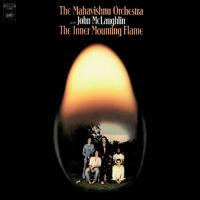The Album That Changed Jazz and Rock
You can bet this blistering, groundbreaking jazz-rock fusion album from 1971 spun Jeff Beck’s head around big time, turning him from heavy metalist-rocker (his version of The Yardbirds’ “Shape of the Things to Come” on the Jeff Beck Group’s album Truth is arguably the first “heavy metal” rock arrangement) to the jazz-fusionist he became on Blow By Blow. Others followed too, of course.
The set of guitarist John McLaughlin’s originals performed by him, drummer Billy Cobham, pianist Jan Hammer, bassist Rick Laird and the manic violinist Jerry Goodman created an immediate sensation upon its release.
I remember dropping some acid with my friend and fellow Fusion Magazine writer the late Tim Jurgens before attending a Mahavishnu Orchestra concert in Central Park August of 1972 and having my head spun around and pretty much yanked off my neck by the opening explosions of “Meeting of the Spirits.”
These guys played loud and then got louder as they went. And as loudly as they played, they played twice as fast and with three times as much precision. And as quickly as they took things up to impossible speeds, they could break it down into cascading colorful plumes that sounded like what cans of paint splashed on a pane of glass might look like.
McLaughlin stepped onto the stage dressed in white caressing his double necked guitar and launched into the album’s deconstructive opener with Cobham’s furiously pounding thunder taking everyone down into deepest nothingness. Then slowly the group rebuilt, taking the picture to the heights of sonic spiritual ecstasy with screaming feedback drenched guitar lines, howling electric violin arches and the kind of super-controlled chaos only a crack team of virtuosi could manage. Everyone starred in that group. It was insane! And when the first tune came to close the audience went positively ballistic$#151the ones still standing anyway.
This set veers between ecstatic triumphalism and apocalyptic, nightmarish Hieronymus Bosch hell, simmering and boiling as it shifts from red to white-hot and never cooling off.
As Neil Young says, “better to burn out than to fade away,” and while the original group remained together for a few more years, they finally split never having, in my opinion topped this still astonishing debut.
This was a fine recording, with excellent dynamics, full bodied deep bass, a particularly well recorded drum kit and a satisfying three dimensional perspective.
Speakers Corner’s 180g reissue is slightly thicker and richer sounding than the thin, bass shy original. A case could be made for either one being superior but ultimately I think the reissue wins for its improved bottom end, greater three-dimensionality and overall harmonic completeness. It even comes with a reproduction of the original’s insert. Like the sonic comparison, the reissue’s insert is thicker and more vibrant than the original.
This is a classic recording that belongs in every rock and jazz collection. A swell reissue. I can’t imagine the CD could possibly get the cymbals as correctly as does this slab of vinyl.




